Finding the best grow bags for cucumbers can be challenging and frustrating; some bags are too small, some are too large, and they cannot support certain plants when they get too heavy.
But don’t worry, our 8 steps based guide is here to help you choose the best one. Read on to learn about the importance of grow bags, methods to cultivate cucumber, and find out about which type of grow bag suits you best. Let’s dive in!
Name: | Gardzen Patch Grow Bag | iGarden Tall Heavy Duty Grow Bags | Smirdx Wide Fabric Grow Bag 24"x8" |
Photo: | |||
Size: | 22.5 x 15.0 inches | 9.25 x 10.04 inches | 24.0 x 8.0 inches |
Material: | Premium BPA Free Non Woven Fabric | Premium 320 g Non Woven Aeration Fabric | Premium Reinforced Sewing Eco-Friendly Fabric |
Colors: | Comes in Black | Comes in Black | Comes in Black, Green, and Purple |
Shape: | Round | Round | Round and Square |
Special Feature: | AZO Free, Excellent Drainage, Sturdy Double Stitched Handles | Inside and Outside Mount, Excellent Drainage, Aeration Fabric | Good Drainage with Easy Storage |
Rating: | |||
Available: |
Contents
Why Grow Bags For Cucumbers?
Cucumbers are one of the most popular types of produce grown in fields and home gardens. They can be grown indoors or outdoors, and they’re great for people who want to grow their own food but don’t have a lot of space. Grow bags for cucumbers are an easy way to grow cucumbers at home.
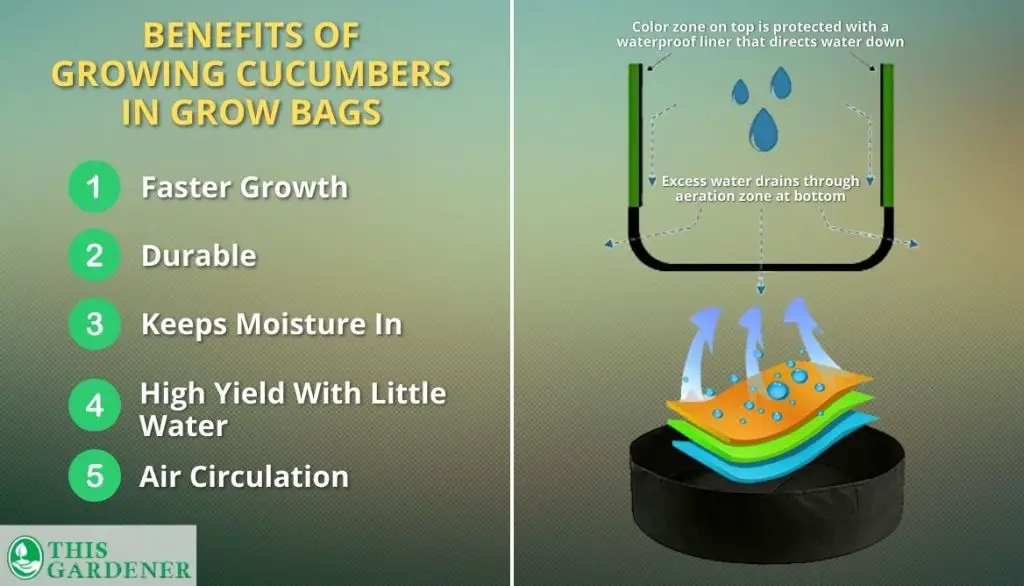
1. Faster Growth
Grow bags are bags designed specifically for cucumbers that help them grow faster and more healthily.
2. Durable
They’re made of strong, durable materials that will protect your plants from pests and diseases without damaging their delicate roots or leaves.
3. Keeps Moisture In
The grow bags also keep moisture in for healthy growth, so your plants won’t get too thirsty!
4. High Yield With Little Water
Planting cucumbers in a grow bag is an easy way to get the best of both worlds: the benefits of growing in soil (drought-resistance, high yields), but with all the convenience of hydroponics (no watering required).
5. Air Circulation
Grow bags are made of breathable material that allows air to circulate freely around your plants while also preventing excess moisture from escaping into your yard or garden.
Quick Care Guide
Common name: | Cucumber |
Scientific nomenclature: | Cucumis Sativus |
Soil mix: | Loamy Soil with a PH between 6.0 and 7.0 |
Direct sunlight: | At least six hours of direct sunlight |
Water: | 1-2 inches per week |
Harvest time: | 50 to 70 days |
Pruning: | Maintain healthy growth and promote the production |
Disease: | Downy mildew, cucumber mosaic virus |
Things To Consider
Grow bags are a great option for growing cucumbers because they help you control the environment in which your plants grow. You’ll need the following things for growing cucumbers.
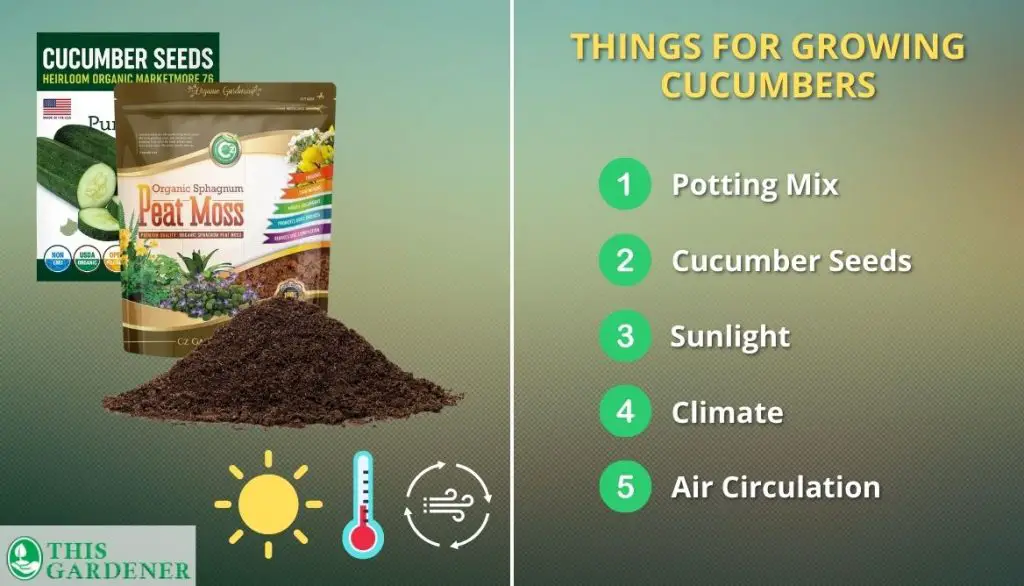
1. Potting Mix
The potting mix should be made from composted soil or composted peat moss and perlite (or vermiculite). These components help keep your plants healthy and strong, so make sure you use them when growing cucumbers in grow bags! You can also add sand for drainage if needed.
2. Cucumber Seeds
Cucumber seeds are available from many seed catalogs or online shops like Amazon.com or eBay. They come in different sizes so you can choose which one suits your needs best.
3. Sunlight
Cucumbers grow best when they have access to sunlight and soil with a good drainage system. For example, if you want to grow cucumbers indoors, choose a location with full sun exposure.
If you prefer to plant them outdoors and have more space, choose a location with good drainage so that the soil around your plants doesn’t become waterlogged or soggy.
4. Climate
When choosing where to plant your cucumbers, keep in mind the type of climate your area has. Cucumbers are sensitive to frost temperatures so if you live in an area that experiences freezing temperatures during the winter months (or even just very cold nights), try planting them somewhere else instead of outside your house or in a greenhouse.
5. Air Circulation
In addition to providing sufficient sunlight and drainage, it’s important for any vegetable garden or greenhouse setup to provide proper air circulation as well.
If there isn’t enough air circulation within your space, plants may not be able to get all of their nutrients from the soil and may.
Top 3 Grow Bags For Cucumbers In Your Garden
1. Gardzen Patch Grow Bag
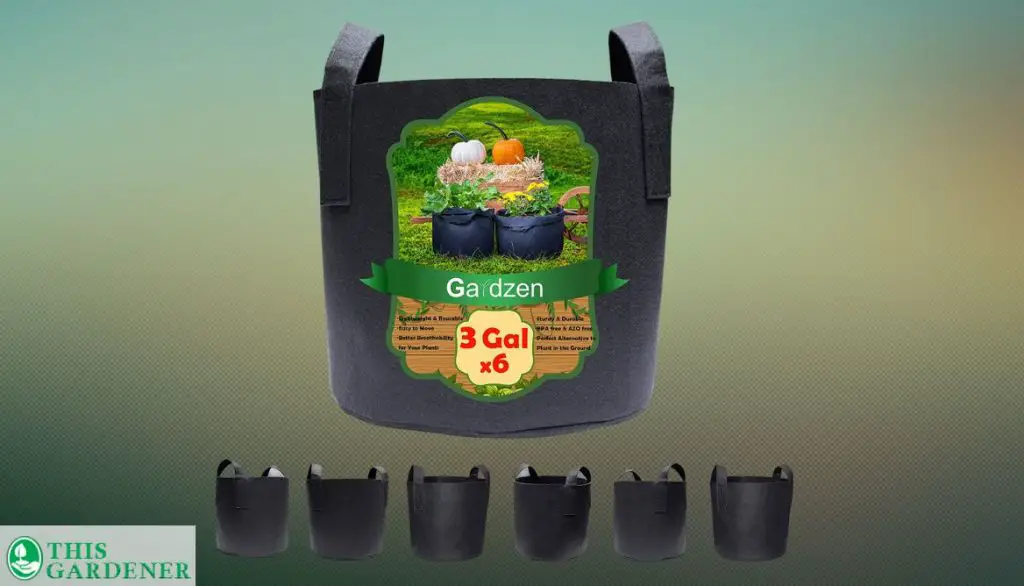
Size: | 22.5 x 15.0 inches |
Material: | Premium BPA Free Non Woven Fabric |
Colors: | Comes in Black |
Shape: | Round |
Special Feature: | AZO Free, Excellent Drainage, Sturdy Double stitched handles |
The Gardzen 6-Pack 3 Gallon Grow Bags are a great option for those looking to start a small garden or expand their current one.
These grow bags are made of aeration fabric, which allows for proper drainage and airflow to the roots of your plants. This can lead to healthier plants with stronger root systems.
- Durable, UV-resistant material
- Proper drainage and aeration
- Hold up to 20 gallons of soil
- Suitable for growing a wide variety of vining vegetables such as tomato cage, cucumbers, peppers, and more
- It also features reinforced handles for easy transport and storage
- They may be too large for small gardens or spaces
2. iGarden Tall Heavy Duty Grow Bags
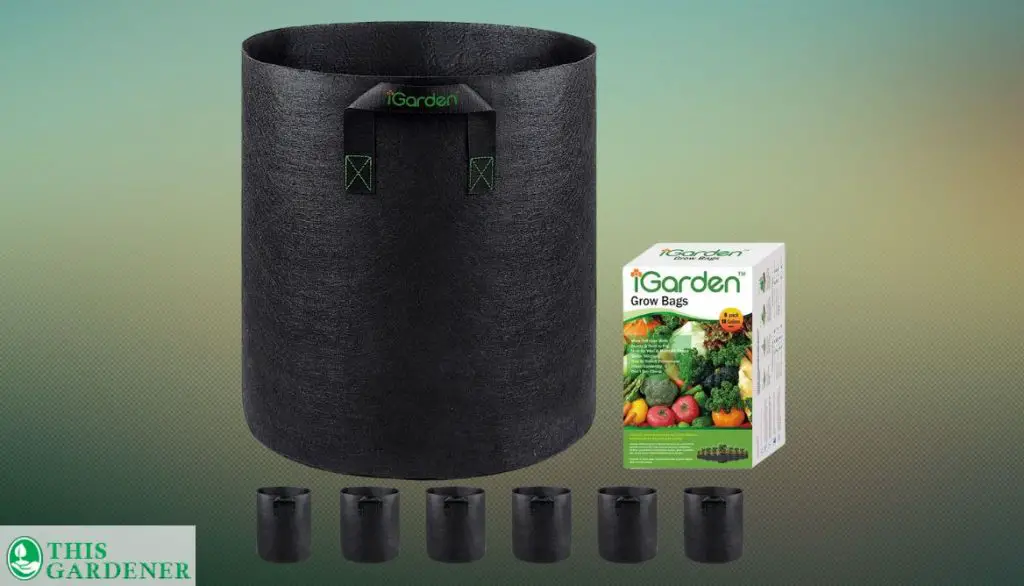
Size: | 9.25 x 10.04 inches |
Material: | Premium 320 g Non-Woven Aeration Fabric |
Colors: | Comes in Black |
Shape: | Round |
Special Feature: | Inside and Outside Mount, Excellent Drainage, Aeration Fabric |
The iGarden Tall Heavy Duty Grow Bags are the perfect solution for those who want to take their gardening to the next level:
- These grow bags are tall, with a 10-gallon capacity, which is ideal for larger plants and even small trees.
- The pack comes with 6 bags, giving you ample space to grow a variety of plants.
- These grow bags are also heavy-duty, with reinforced handles that make them easy to move around, whether you’re relocating them to a sunnier spot or harvesting your crops.
- Tall and straight design
- Allows for ample room for root growth
- Versatile planting options
- Made of 320g thickened non-woven fabric
- Provides more oxygen to the roots
- Reusable
- Lack of consistently manufactured product
3. Smirdx Wide Fabric Grow Bag 24″x8″
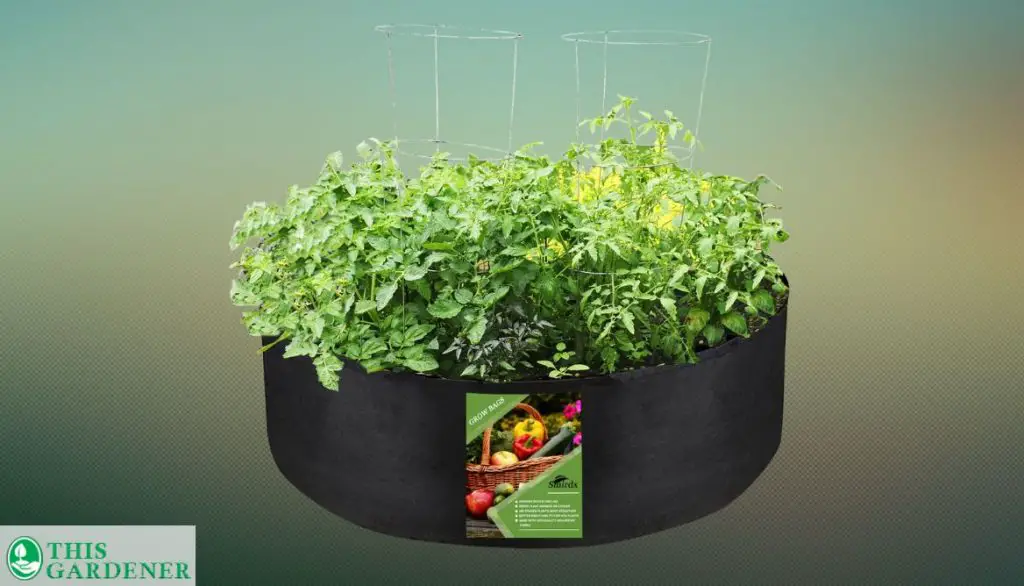
Size: | 24.0 x 8.0 inches |
Material: | Premium Reinforced Sewing Eco-Friendly Fabric |
Colors: | Comes in Black, Green, and Purple |
Shape: | Round and Square |
Special Feature: | Good drainage with easy storage |
The Smirdx wide grow bag fabric is a must-have for any gardener looking to expand their growing space. Measuring 24 inches by 8 inches, this heavy-duty fabric grow bag is perfect for growing a variety of plants, from vegetables to flowers.
The breathable fabric material allows for proper aeration and drainage, while the large size gives your plants plenty of room to grow. The reinforced handles make it easy to move the grow bag around, and the durable construction ensures that it will last for many seasons to come.
- Eco-friendly, breathable
- Reusable, reinforced sewing
- Durable and easy to move
- Humanized design tending the garden much easier
- Eliminates the need for stooping and bending
- Too heavy
How Many Cucumber Seeds Per Grow Bag?
The number of cucumbers you can grow per grow bag depends on the size of the cucumber and the type of growing medium you use. There are two main types of growing medium: soil and hydroponics.
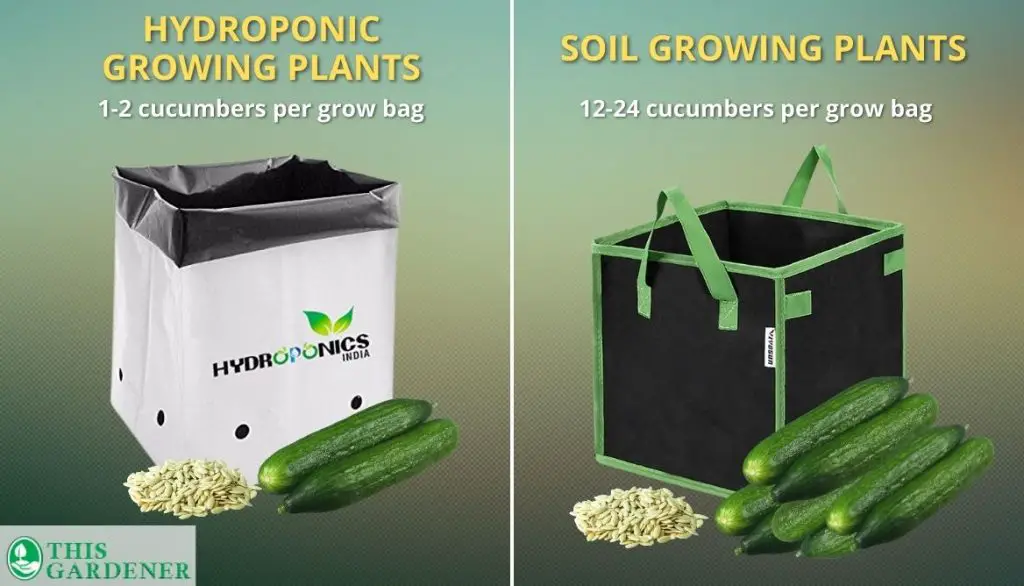
Soil Growing Plants
- When using the soil-based growing medium, you’ll need to grow your cucumbers in a container that has room for at least 12 inches of root space.
- If you have 2 or 3 plants in a slot each about 1 foot apart, you’ll get 24 cucumbers per grow bag.
- If your plants are in a 4-inch diameter slot, you’ll get 12 cucumbers per grow bag.
Hydroponic Growing Plants
The number of cucumbers that can be grown per grow bag for hydroponics medium can vary depending on the size of the cucumber plants and the size of the grow bag.
- Typically, one or two cucumbers can be grown per grow bag in a hydroponics system.
- However, it is important to provide enough space for the plants to grow and to ensure they receive adequate light and nutrients.
What Size Grow Bag For Cucumbers?
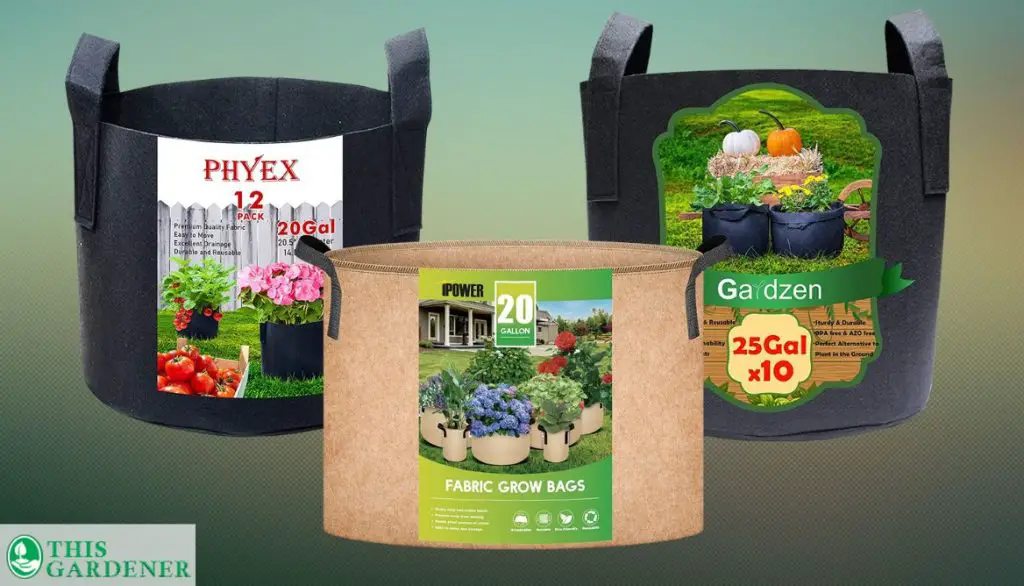
If you’re growing your own cucumbers, you’ll want to consider the size of the grow bag.
- Cucumber vines need space, so they will Two Additional Methods To Grow Cucumbers In Grow Bagsneed a larger grow bag than other vegetables. A grow bag that is at least 18 inches deep and 24 inches wide is recommended for cucumbers.
- Growing cucumber plants and other multiple plants in one grow bag, you will need a larger size to accommodate the additional space needed for the roots and vines.
- It’s also important to ensure proper air circulation in the grow bag for cucumber seeds and also make sure it is made up of fabric, not plastic bags cucumbers prefer well-draining soil.
- Consider the final size of the cucumber plant and the type of cucumber you will be growing, as some varieties grow plants larger than others.
How To Grow A Cucumber Plant In A Bag?
Growing a cucumber plant in a bag is really easy. You can even have it done within a few days. All you need is some water and soil, and you are good to go!
Follow these steps to get your own cucumber seeds growing like a weed:
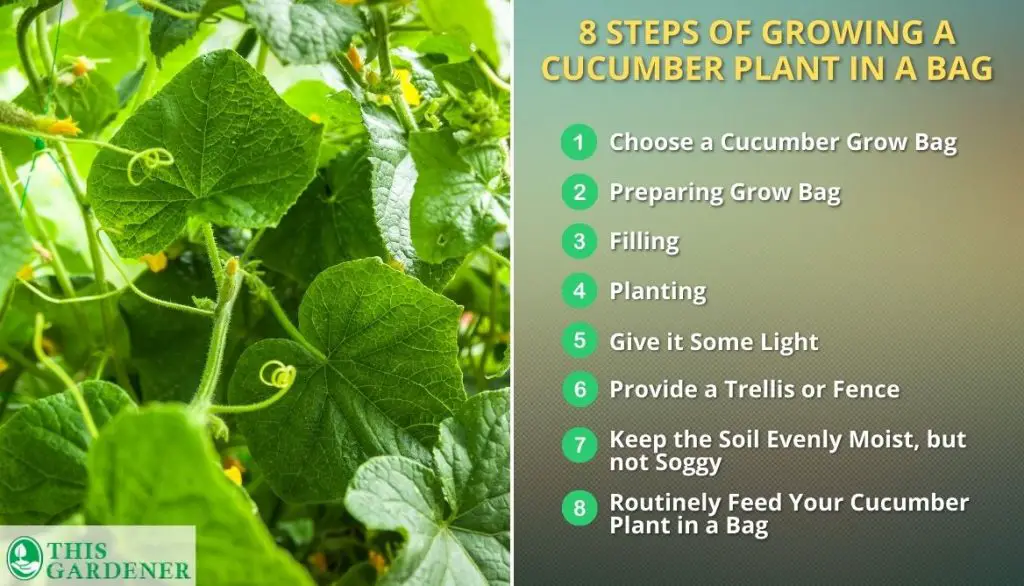
1. Choose A Cucumber Grow Bag
You’ll need a grow bag for your cucumber plant. They come in different sizes and materials, so be sure to choose one that fits the size of your cuke.
Check that the material isn’t too heavy—you don’t want it weighing down your plant!
2. Preparing Grow Bag
After choosing the bag, the next step is to prepare it to grow cucumbers.
- The first thing you have to do is remove any labels from the inside of the bag, or any residue from previous use.
- You should also wash it with warm water and soap, then allow it to dry completely before using it again for this purpose.
3. Filling
Fill your grow bag with soil until it’s about half-full, you don’t want too much air in there with your plants!
4. Planting
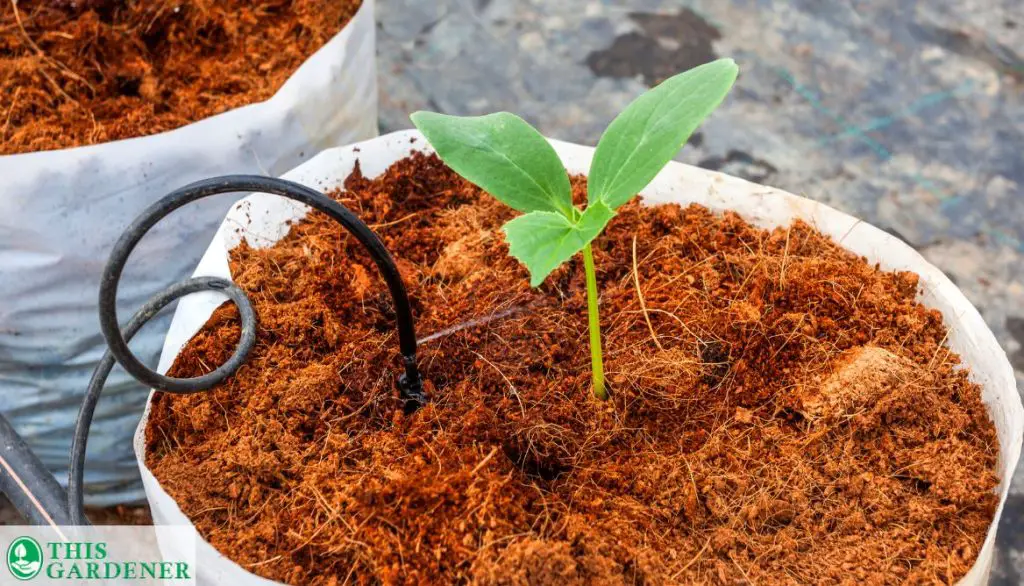
First, you need to make sure you have plenty of space in your grow bag for planting cucumber seeds. If you’re planting cucumbers on the patio or deck, that’s fine; but if you’re going to be growing them indoors, you’ll want at least 4 square feet of space per plant to grow cucumbers.
5. Give It Some Light
The second challenge is light. Cucumbers need bright light and indirect sunlight to thrive, so make sure they have enough of both to get their full potential.
6. Provide A Trellis Or Fence
Trellises or fences are necessary to support your cucumber plant and help it grow vigorously. In your garden space, they will also provide shade for the plant, which is important because it helps protect against severe weather conditions such as heat and cold.
7. Keep The Soil Evenly Moist, But Not Soggy
The soil should be kept evenly moist, but not soggy. Slow-release fertilizer also helps to maintain moisture. If you need to water it, let it drain before watering again. You should also try to avoid diluted liquid fertilizer of the cucumber seeds too much.
The fertilizer can encourage root rot and other pests such as grubs.
8. Routinely Feed Your Cucumber Plant In A Bag
Once your cucumber plant has established itself, follow these instructions for the best results:
- Supplement its diet with a liquid slow-release fertilizer high in nitrogen, phosphorous, and potassium.
- Feed every two weeks and monitor the growth regularly, adjusting the schedule as needed.
- Avoid over-fertilizing and make sure the soil is moist but not waterlogged.
- Keep an eye out for yellowing or wilting leaves, which can be a sign of nutrient deficiencies.
Two Additional Methods To Grow Cucumbers In Grow Bags
Growing cucumber seeds in grow bags can be a lot of fun, but it’s not always easy. Here are two methods that help you to grow cucumbers in grow bags with ease!
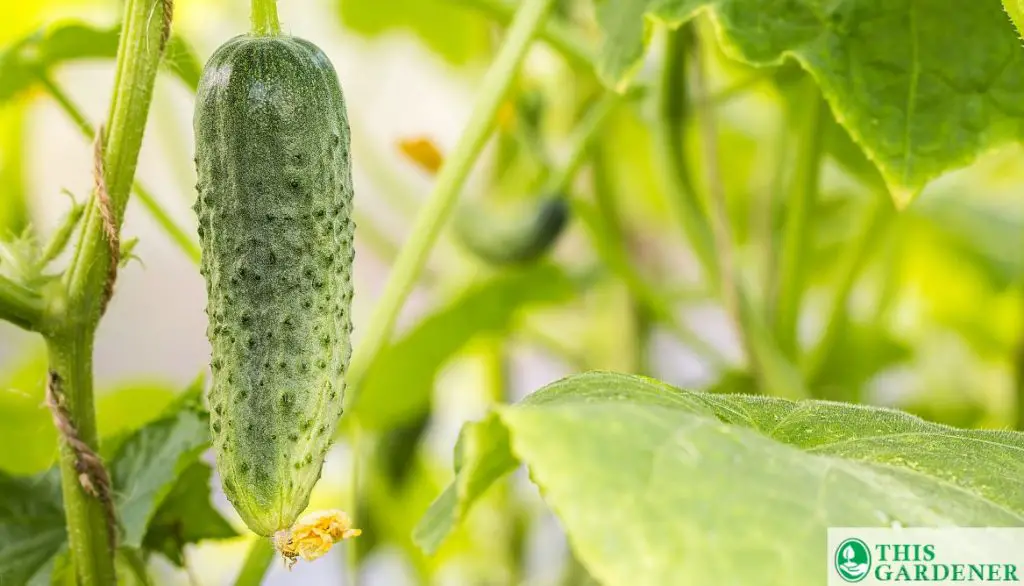
1. Conventional Method
This is the most common method of growing fresh cucumbers in grow bags. It involves planting seedlings or cucumber seeds in the grow bag and allowing them to grow vertically. The cucumbers will need to be trained to grow up a trellis or support system, as they will naturally try to grow outwards.
- Easy mainrttainance
- All year Round growth
- Easy control of the growing environment
- Increased Chances of damage
- Risk of pests
2. Swinging Method
This method involves planting cucumbers in a grow bag that is suspended from a swing or a trellis (like a tomato cage). The bag is filled with soil and a seedling or seed is planted. As the cucumber plant grows, it will naturally trail downwards, creating a hanging vine.
It’s perfect for small gardens or greenhouses and it’s also great for using up vertical space and drip irrigation system.
- Increased yield per square foot of growing space
- Better air circulation, which can reduce disease and pest problems
- Efficient use of space, as the plants, are suspended above the ground
- Easier access to the plants for maintenance and harvesting
- Less damage to the fruit from contact with the ground
- Reduced need for staking or trellising
- Has to be watered frequently
Troubleshooting
Growing cucumbers in grow bags can be a rewarding experience, but like any gardening endeavor, it can also come with its own set of challenges. Here are some common troubleshooting issues that may arise when growing cucumbers in grow bags and how to address them.
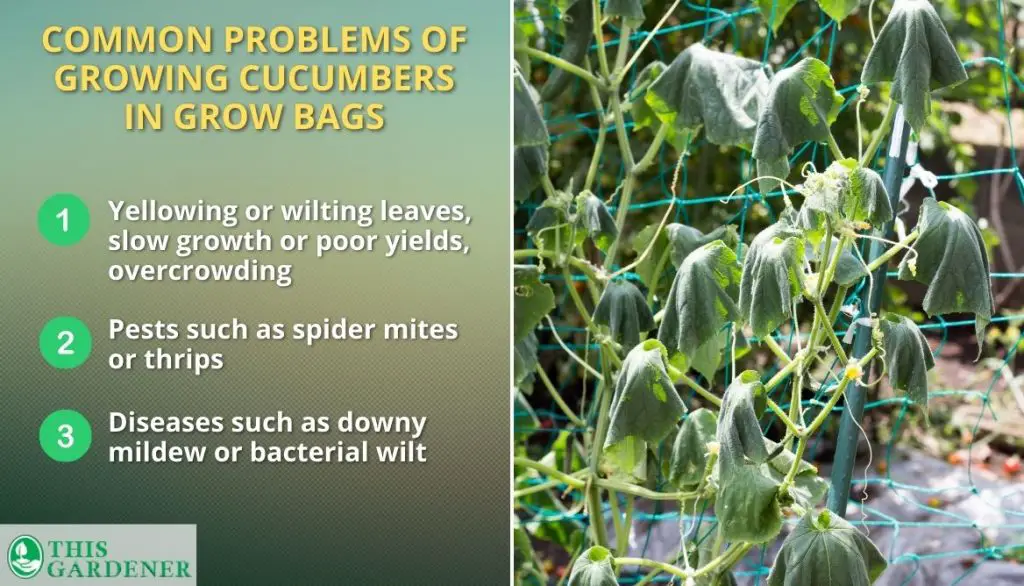
1. Growing Problems
According to studies, the following 3 are the main growing problems related to the cucumber plant:
Yellowing Or Wilting Leaves
this can be a sign of nutrient deficiencies or over-watering. Make sure to regularly fertilize your cucumber plants and ensure proper drainage in the grow bag.
Slow Growth Or Poor Yields
This can be caused by a lack of sunlight, too much shade, or poor soil quality. Make sure your cucumber plants are getting enough sunlight and consider using a high-quality potting mix
Overcrowding
Cucumber plants need room to grow and develop, so make sure to provide them with enough space in the grow bag.
2. Pests
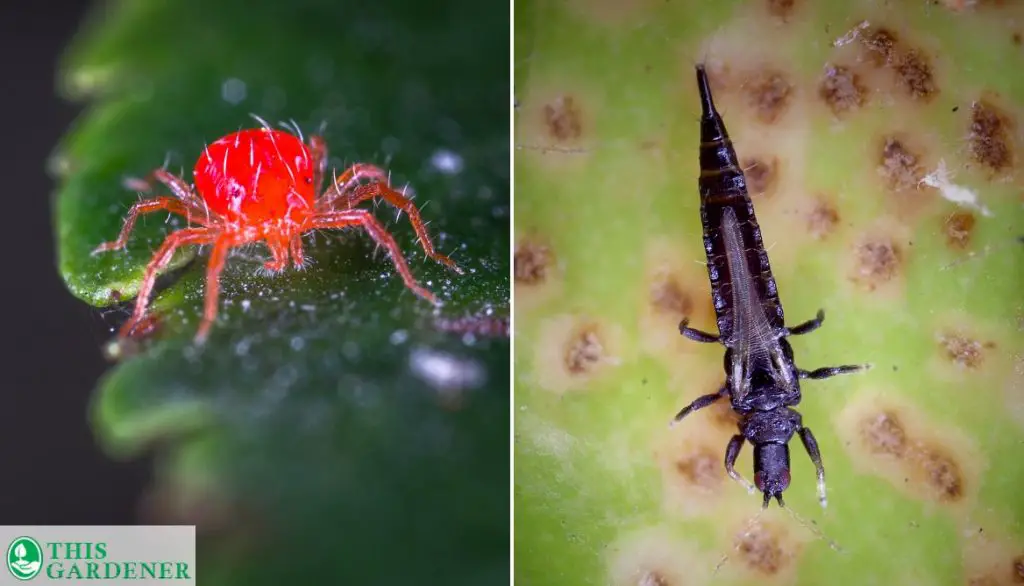
Spider mites: these tiny arachnids suck the sap from cucumber leaves, causing yellowing and wilting. They can also spin webs on the leaves and stems.
Thrips: These tiny insects can cause damage to cucumber leaves and can also spread disease
3. Diseases
Following are the known diseases in cucumbers which damages the fruit.
Downy Mildew
This disease causes the yellowing or browning of leaves and can cause plant cucumbers to wilt. To control it, make sure to provide your cucumber plants with good air circulation and avoid overcrowding.
Bacterial Wilt
It causes wilting of leaves and can be fatal to cucumber plants. To control it, remove and destroy infected plants and avoid planting in the same spot for at least three years.
Growing Cucumbers Indoors In Grow Bags
Growing cucumbers indoors in grow bags can be a great way to enjoy fresh, homegrown cucumbers year-round. Here are a few tips to help you get started:
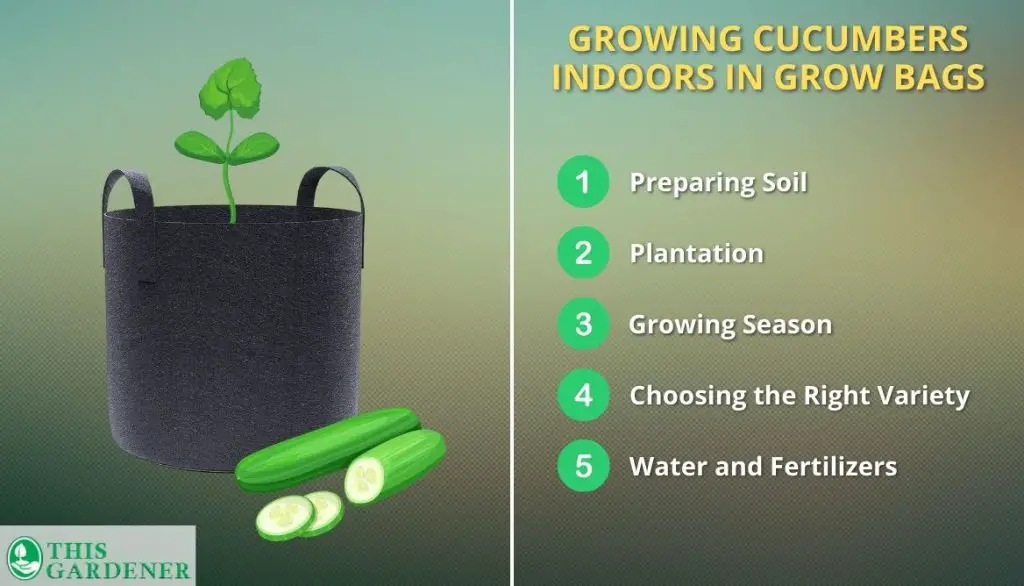
1. Preparing Soil
Prepare the soil in your grow bag by mixing equal parts sand and peat moss (or compost). This will help keep excess moisture out of the soil while also ensuring that the roots of your plants have some support when they begin growing.
2. Plantation
The season for growing cucumbers varies depending on the climate and growing conditions in a specific area. In general, cucumbers are warm-weather plants and are typically planted in the spring, after the last frost date.
3. Growing Season
In areas with milder climates, cucumbers can be planted in the growing season as early as February or march, while in areas with colder climates, planting should be delayed until April or May. Cucumbers typically take 50 to 70 days to mature, so they should be ready for harvest in summer.
4. Choosing The Right Variety
Look for varieties that are specifically suited for the indoor growing season.
When you’re selecting seeds for your cucumber plants, make sure that they are high enough quality to withstand being transplanted into your garden later on. The lower-quality seeds will not produce as much fruit or yield as much fruit as higher-quality seeds do.
5. Water And Fertilizers
Cucumbers need lots of water and fertilizer to grow well, and they also require lots of sunlight. So if you live in an area that gets very little sunlight, consider growing cucumbers indoors.
Best Cucumber Varieties For Grow Bags
If you’ve been thinking about getting into growing your own cucumbers, here are our top picks for the best varieties of cucumbers to plant in grow bags.
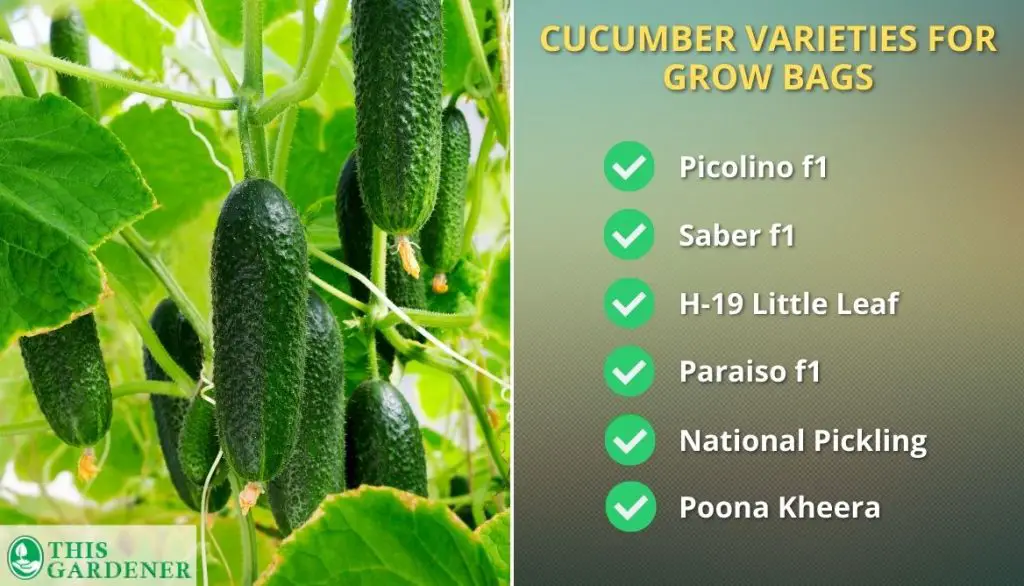
Picolino F1
This variety is known for its high yields and sweet flavor. It’s an excellent choice for those who want to grow their own cucumbers or sell them at farmers’ markets.
Saber F1
Saber f1 is another popular variety that produces large fruits with thin skins, making it perfect for pickling or eating fresh. If you’re looking for something to plant in your garden this year, this is the one!
H-19 Little Leaf
H-19 little leaf – this variety produces small, tender fruits with a mild flavor that makes them perfect for salads and sandwiches. The leaves are also edible, so you can harvest them along with the fruit if you want!
Paraiso F1
Paraiso f1 produces firm green fruits that are great for slicing and eating fresh or pickling. It’s also resistant to disease and pests so it’s easy to grow!
National Pickling
National pickling – this variety produces large green fruits with thin skins that make it perfect for pickling or eating fresher f1.
Poona Kheera
Poona kheera is a type of cucumber that is popular in India. Its pale green color, delicate skin, and crisp texture. It is known for its high water content and is considered to be a cooling vegetable that helps to hydrate and refresh during hot weather. It’s a good source of vitamin c and potassium.
FAQ
What Size Grow Bag Is Best For Cucumbers?
A grow bag that is at least 18 inches deep and 24 inches wide is recommended for cucumbers.
Do Cucumbers Grow Well In Grow Bags?
Yes, cucumbers grow well in grow bags.
What Is The Best Container To Grow Cucumbers?
The best container to grow cucumbers is a Gardzen grow bag.
What Makes Cucumbers Grow Faster?
In a word: sunlight. Cucumbers need sunlight to grow, and they’re especially sensitive to light when it’s too hot or too cold.
Should I Water Cucumber Plants Every Day?
Yes, you should water the cucumber every day.
Conclusion
We hope this extensive guide has given you a better idea of what to look for when you shop for cucumber grow bags. From what materials to go with, to how many bags to buy, to how you should use them in your garden, we’ve covered it all.
Our recommended product is Gardzen Patch Grow Bag because of its aeration fabric which allows for proper drainage and airflow to the roots.
So, which grow bag did you like? Be sure to let us know about your choice in the comments section below. And as always, happy gardening!
- How to Get Potatoes to Sprout Eyes: Detailed Growing Guide with 3 Options - July 31, 2023
- Weight of a Medium Potato: Revealed in Detailed Guide - July 29, 2023
- Maris Piper Potatoes: 9 Substitutes You Should Know About - July 27, 2023
Hello! I’m Jessica Zander, a garden coach and consultant based in the Boston area (zone 6b), offering virtual consultations across the country and Canada.
I’ve been passionate about gardening since the early 1990s, and in 2022, I launched You Can Do It Gardening to empower individuals to feel more confident in their gardening endeavors.
Following a 30-year career in nonprofit finance and operations, I transitioned out of that field in mid-June of 2023 due to the growing demand for coaching services. Interestingly, my years of presenting financial statements to boards and finance committees proved to be valuable experience for teaching people about gardening! I enjoy sharing skills, providing guidance and suggestions, and collaborating efficiently with clients to make significant improvements to their outdoor spaces, both small and large. I also regularly teach at the Arlington Continuing Education and Cambridge Adult Education.
My approach is direct and practical, akin to Mary Poppins, but tailored to your garden. Clients find satisfaction in saving money and taking pride in their own gardening achievements.

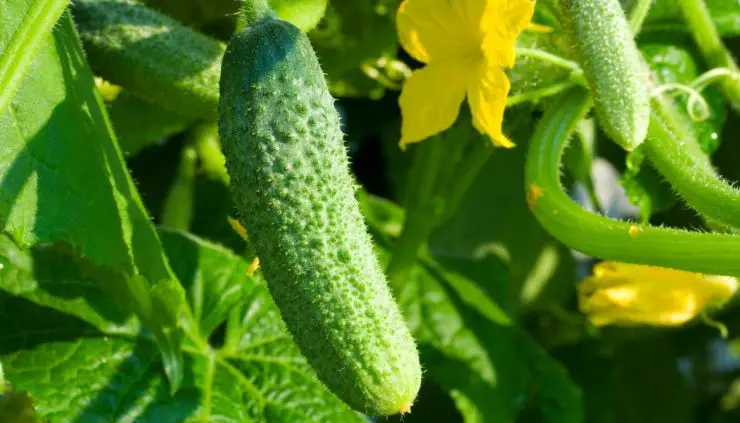




Add comment